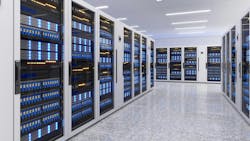The Future of Data Center Cooling: Embracing Emerging Technologies while Maintaining Air Cooling
As the data center industry evolves and artificial intelligence (AI) workloads become increasingly common, the topic of cooling technologies has gained significant attention. While liquid cooling is often seen as the future, it is essential to recognize that air cooling, which has served the industry for decades, still has its place. In this article, we will explore the benefits of hybrid designs and the importance of embracing emerging technologies while planning for the future.
The Five to Ten-Year Plan
Looking at future goals, data center planning requires a long-term vision and consideration of future needs. This applies not only to hyperscale, edge, and enterprise facility operators, but also to colocation facilities engaging with their customers. Conversations surrounding future goals, needs, and requirements are vital to make informed choices about cooling technologies.
Air Cooling Innovation: Going Beyond Perimeter Cooling
Air cooling technology has not stagnated; it has evolved over the years to meet increasingly demanding requirements. The advent of row cooling has allowed for higher-density racks, with successful implementations of 40-50 kW racks. Critical factors such as containment or perimeter units can help optimize air cooling performance.
Embracing Hybrid Cooling Solutions for Modern Data Centers
Contrary to popular belief, air cooling is not going away anytime soon. Enterprise data centers, which don't require extensive cooling, form a significant portion of the industry. It is unrealistic to assume that all data centers will switch entirely to liquid cooling. Instead, air and liquid cooling tailored to specific application requirements will likely be the norm.
Hybrid designs offer a practical approach when the specific cooling requirements are uncertain. By combining air and liquid cooling systems, organizations can maintain flexibility. This approach provides the opportunity to adapt to changing needs, whether it be incorporating liquid cooling in the future or optimizing existing air-cooled systems. While hybrid designs may involve additional upfront costs, the long-term benefits and flexibility outweigh the initial investment.
Retrofitting data centers to add liquid cooling capabilities can be expensive. It is better to plan ahead and design your data centers in a way that can accommodate both liquid and air-cooling technologies. In this hybrid design, you can cool racks of 50 kW and below efficiently with air cooling technologies. Anything above 80 kW will have to be cooled with liquid cooling technologies.
Evaluating Total Cost of Ownership (TCO)
Assessing the total cost of ownership is crucial when choosing between air and liquid cooling. While liquid cooling may provide more efficient cooling, evaluating overall costs, including construction expenses involved in changing the data center layout is essential. Each organization must consider factors like load availability, space constraints, predicted future demand, and energy efficiency to decide the most cost-effective cooling solution.
Day-to-day operations and downtime maintenance are key aspects of data center operation, and their impact on downtime cannot be ignored. Liquid cooling systems often require specific procedures, such as working with oil-based single-phase immersion systems, which can pose challenges for routine maintenance. While two-phase systems offer hermetically sealed solutions, they may still incur additional costs. It is essential to compare the maintenance requirements of different cooling technologies when making decisions.
The Importance of Planning for the Future
In an ever-changing landscape, planning plays a crucial role. With different regulations and sustainability standards in each country, a one-size-fits-all approach is not feasible. Lack of standardization and the evolving nature of cooling technologies require organizations to plan ahead. Organizations can bridge the current gap in the industry by focusing on future needs, making specific requirements, and ensuring the right specifications.
While emerging technologies like single-phase and direct-to-chip cooling gain attention in the data center industry, air cooled cooling technologies retain their significance. The future of cooling lies in embracing hybrid designs that combine air and liquid cooling, offering flexibility and adaptability. Organizations can make informed decisions and optimize their data centers by engaging in conversations about future goals and needs. It is crucial to remember that planning for the future and embracing new technologies while still utilizing the proven benefits of air cooling will shape the success of data centers in the years to come.
About the Author

Danielle Rossi
Danielle Rossi is Global Director – Mission Critical Cooling for Trane. Danielle has 17+ years in data center solution design and engineering for hyperscale, colocation, enterprise, edge, and government environments. In her current role, Danielle manages global mission-critical cooling products and processes to provide a standardized deliverable for customers executing projects worldwide.
Trane® – by Trane Technologies – continues to innovate its HVAC systems & controls and energy services for mission critical customers. With over 37,000 employees in 58 countries and serving approximately 100 countries in 2023, Trane is well-positioned to support hyperscale and co-location data centers with their cooling needs across the globe.



